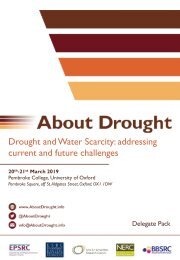About Drought Handbook: Outputs & Impacts
As the UK’s £12m Drought and Water Scarcity (DWS) research programme reaches its conclusion with a final event at The Royal Society in London, this handbook draws together the key outputs and outcomes. The book also features a series of interviews with our leading stakeholders, which highlight how successfully we have met our objectives to produce cutting-edge science that has made a demonstrable impact on how decision-makers manage water scarcity in the UK.
As the UK’s £12m Drought and Water Scarcity (DWS) research programme reaches its conclusion with a final event at The Royal Society in London, this handbook draws together the key outputs and outcomes. The book also features a series of interviews with our leading stakeholders, which highlight how successfully we have met our objectives to produce cutting-edge science that has made a demonstrable impact on how decision-makers manage water scarcity in the UK.
- No tags were found...
You also want an ePaper? Increase the reach of your titles
YUMPU automatically turns print PDFs into web optimized ePapers that Google loves.
Unblinkered Approach to Managing Water<br />
Resources<br />
Wildlife Trust for Beds, Cambs & Northants<br />
“In nature conservancy we spend a lot of time working on technical aspects<br />
and it is easy to get blinkered by that so it was good to meet farmers from<br />
neighbouring areas, not just those on our ‘patch’, and really useful to hear<br />
their perspective on when they need water and what for – I was able to<br />
understand the day-to-day practicalities.”<br />
Kate Carver, Great Fen Project Manager, Wildlife Trust for Bedfordshire, Cambridgeshire & Northamptonshire<br />
From science to songs and a ‘mock trial’ of water<br />
use evidence – no-one could accuse <strong>About</strong> <strong>Drought</strong>’s<br />
research of being blinkered!<br />
Kate Carver, who was invited to contribute to the<br />
Bevills Leam Local Action Group (LAG) in rural<br />
Cambridgeshire, found herself acting as a ‘witness’ in a<br />
traditional Sardinian-style trial of evidence performed<br />
in Ramsay Rural Museum that enabled the community<br />
to expose and address the conflicting perspectives,<br />
interests and priorities around drought and water<br />
scarcity.<br />
On another occasion Kate was invited to feature<br />
in ‘Utopia’, a festival/exhibition at Somerset House,<br />
London, marking the 500th anniversary of Thomas<br />
More’s book ‘Utopia’, bringing people from around the<br />
UK. Several members of the Bevills Leam DRY LAG<br />
attended including Kate. They had an exhibition stand<br />
about the Bevills Leam LAG and the DRY project, and<br />
engaged with those attending the event.<br />
DRY’s creative community events elicited stories that<br />
were woven into a community song written by Sharron<br />
Kraus ‘The River is a Snake’ which you can hear on<br />
DRY’s website - www.dryproject.co.uk.<br />
It opened up a new world of social science engagement<br />
which enabled Kate to meet people and interests from a<br />
broad variety of sectors and affiliations, and this fed into<br />
the Great Fen’s new Water Works project, funded by<br />
the People’s Postcode Lottery Dream Fund, to promote<br />
sustainability.<br />
Kate says: “Being involved with DRY has been<br />
experience- and mind-expanding! We at Great Fen had<br />
not worked with social scientists before so that was<br />
quite an innovation for us. It introduced us to a whole<br />
new group of people who had different ideas and ways<br />
of doing things and we learned a lot.<br />
“The methodology was interesting and useful. We<br />
learned to not be afraid of new methods, not have<br />
preconceived ideas about different groups of people and<br />
different sectors. It was a freer way of working but still<br />
with academic rigour.<br />
“The DRY project was a societal indicator that showed<br />
the benefits of bringing different groups together to<br />
work for sustainability, it pointed the way.<br />
“In nature conservancy we spend a lot of time working<br />
on technical aspects and it is easy to get blinkered by<br />
that so it was good to meet farmers from neighbouring<br />
areas, not just those on our ‘patch’, and really useful to<br />
hear their perspective on when they need water and<br />
what for – I was able to understand the day-to-day<br />
practicalities.<br />
“The area I cover is the driest part of the UK and one<br />
of the most productive agricultural areas. There is great<br />
pressure on the land for housing development but also<br />
great pressure on nature.<br />
“Availability and use of water is a constant preoccupation<br />
in this part of the world and has been for centuries.<br />
Water has been being drained away since the 17th<br />
Century, the whole agricultural system is predicated on<br />
drainage, on pumping water away. But when peat dries<br />
out it emits carbon dioxide, if we re-wet the area it can<br />
mitigate carbon loss so in terms of climate change these<br />
natural systems will be critical in helping this country to<br />
adhere to its emission goals.”<br />
Kate is not the only stakeholder involved in <strong>About</strong><br />
<strong>Drought</strong>’s projects to suggest that the next step should<br />
be viewing water management as one issue, bringing<br />
drought and flood research together.<br />
She says: “I believe the remit should now be expanded<br />
into an integrated approach to water management,<br />
bringing in other elements as well – pollination, carbon<br />
sequestration, biodiversity … all the eco system services<br />
that the landscape provides could benefit from the DRY<br />
LAG approach.”<br />
Interview by Sally Stevens<br />
30




